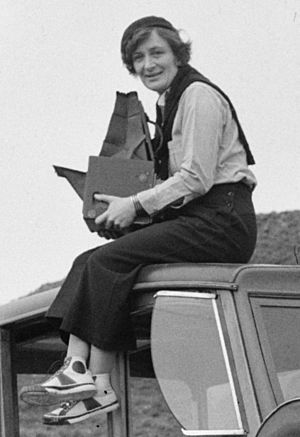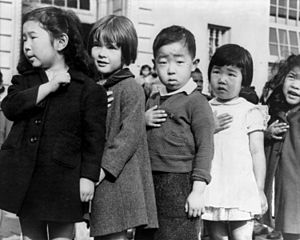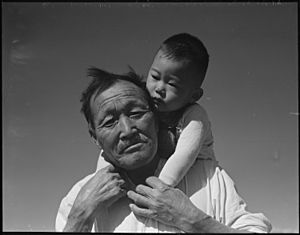Dorothea Lange facts for kids
Quick facts for kids
Dorothea Lange
|
|
|---|---|

Lange in 1936
|
|
| Born |
Dorothea Margaretta Nutzhorn
May 26, 1895 Hoboken, New Jersey, U.S.
|
| Died | October 11, 1965 (aged 70) |
| Known for | Documentary photography, photojournalism |
|
Notable work
|
1936 photograph of Florence Owens Thompson, Migrant Mother |
| Spouse(s) |
|
| Awards | California Hall of Fame |
Dorothea Lange (born Dorothea Margaretta Nutzhorn; May 26, 1895 – October 11, 1965) was an American photographer. She is famous for her documentary photos, especially those taken during the Great Depression. Her pictures helped people understand the struggles faced by many during that difficult time. Lange's work greatly influenced how documentary photography developed.
Contents
Early Life and Challenges
Dorothea Lange was born in Hoboken, New Jersey. Her parents were Johanna Lange and Heinrich Nutzhorn. She had a younger brother named Martin. Two important events in her childhood shaped her future.
Overcoming Polio
When Dorothea was seven, she got polio. This illness left her with a weak right leg and a permanent limp. She once said that this limp "formed me, guided me, instructed me, helped me, and humiliated me." It was a big part of who she became.
A New Start in New York
Five years later, her father left the family. This led them to move from their home in New Jersey to a poorer area in New York City. Later, Dorothea decided to use her mother's maiden name, Lange, instead of her father's name.
Growing up in New York, she went to PS 62 on Hester Street. She often explored the city streets by herself while her mother worked. She loved watching all the different people. This taught her how to observe others without disturbing them. This skill became very useful in her later work as a documentary photographer.
Starting a Photography Career
Dorothea Lange graduated from Wadleigh High School for Girls in New York City. Even though she had never owned a camera, she knew she wanted to be a photographer. She began studying photography at Columbia University. Her teacher was Clarence H. White. She also learned from working in several photography studios in New York.
Moving to San Francisco
In 1918, Lange left New York with a friend. They planned to travel the world, but their trip was cut short when they were robbed. She decided to settle in San Francisco. There, she found a job at a photography supply shop. She met other photographers and an investor who helped her open her own successful portrait studio.
In 1920, she married Maynard Dixon, a well-known painter. They had two sons, Daniel and John. Her studio business supported her family for the next fifteen years. At first, Lange mostly took portraits of wealthy people in San Francisco. But when the Great Depression began, she changed her focus.
Documenting the Great Depression
By 1933, the Great Depression had caused huge problems. Many people in the U.S. were jobless and homeless. In some areas, droughts and dust storms made things even worse. During the 1930s, about 300,000 people moved west to California, hoping to find work. These families were often called "Okies," even if they weren't from Oklahoma. They traveled in old cars, moving from place to place to find farm work.
Lange started photographing these struggling people. She left her studio to document their lives on the streets and roads of California. She traveled with her camera, showing how much the Depression had affected society and the economy. This is when Lange found her true calling as a photographer. She became known as one of the first "documentary" photographers.
Her photos of the unemployed and homeless, like White Angel Breadline (1933), caught the attention of other photographers and the media. This led to her working for the federal Resettlement Administration (RA), which later became the Farm Security Administration (FSA).
Lange had a special way of talking with her subjects. She made them feel comfortable, which helped her write down their important comments to go with her photos. These notes often shared personal details about the people she photographed.
Working for the Government
Resettlement Administration and FSA
Lange and Maynard Dixon divorced in 1935. Soon after, she married Paul Schuster Taylor, an economics professor. For the next five years, they traveled across California and the Midwest. They documented poverty in rural areas, especially the struggles of sharecroppers and migrant workers. Taylor interviewed people and collected facts, while Lange took photos and gathered information. They lived and worked from Berkeley for the rest of her life.
Working for the RA and FSA, Lange's images showed the public the difficulties faced by the poor and forgotten. Her photos were sent to newspapers across the country. These powerful images became symbols of the era.
One of Lange's most famous photos is Migrant Mother, taken in 1936. The woman in the picture is Florence Owens Thompson. Lange told a San Francisco newspaper editor about the conditions at the camp where she met Thompson. She showed him her photos. The editor told federal officials and published an article with some of the images. Because of this, the government quickly sent help to the camp to prevent people from starving.
Thompson's son later said that while some details in Lange's story were not quite right, the photo's power came from showing both the strength and the needs of migrant workers. Twenty-two of Lange's FSA photos were used in John Steinbeck's book The Harvest Gypsies in 1936. The photographer Martha Rosler said that Migrant Mother became one of the most reproduced photos in the world.
Documenting Japanese American Internment
In 1941, Lange received a special award called a Guggenheim Fellowship for her photography. But after the attack on Pearl Harbor, she gave up the award. She took on a new assignment for the War Relocation Authority (WRA). Her job was to document the forced removal of Japanese Americans from the West Coast of the U.S.


She traveled across California, photographing families who were told to leave their homes. Lange visited several temporary centers and then focused on Manzanar, one of the first permanent internment camps.
Much of Lange's work showed the worry and confusion caused by this forced removal. She photographed piles of luggage, families waiting for transport with ID tags, and people of all ages who were stunned and didn't understand why they had to leave. Her photos, like one of American schoolchildren pledging allegiance to the flag just before being removed from their homes, are powerful reminders of this difficult time.
Because her images were so strong, authorities kept most of Lange's photos of the internment process hidden during the war. Today, her photos of these events are available to the public in the National Archives and at the Bancroft Library at the University of California, Berkeley.
Later Career and Legacy
In 1945, the famous photographer Ansel Adams invited Lange to teach. She joined the first fine art photography department at the California School of Fine Arts (CSFA). Other well-known photographers like Imogen Cunningham and Minor White also taught there.
Founding Aperture Magazine
In 1952, Lange helped start a photography magazine called Aperture. In the mid-1950s, Life magazine asked Lange and Pirkle Jones to create a documentary about the town of Monticello, California. This town was being flooded to create Lake Berryessa. Life decided not to publish the story, so Lange dedicated an entire issue of Aperture to their work. This collection was later shown at the Art Institute of Chicago in 1960.
Final Years and Recognition
Lange's health declined in her last ten years. She suffered from several illnesses, including what was later called post-polio syndrome. She passed away from esophageal cancer on October 11, 1965, in San Francisco. She was 70 years old.
Just three months after her death, the Museum of Modern Art (MoMA) in New York City held a special exhibit of her work. Lange had helped plan this exhibit herself. It was MoMA's first solo show for a female photographer. In 2020, MoMA held another exhibit of her work. Critics noted that her photos often needed words to explain their full meaning and historical importance.
Dorothea Lange has received many honors for her contributions to photography.
- In 1984, she was inducted into the International Photography Hall of Fame and Museum.
- In 2003, she was inducted into the National Women's Hall of Fame.
- In 2006, an elementary school in Nipomo, California, was named after her. This was near where she took the Migrant Mother photo.
- In 2008, she was inducted into the California Hall of Fame.
- In 2018, her hometown of Hoboken, New Jersey, honored her with a mural.
- In 2019, another mural of Lange was painted in Roseville, California.
Collections
Her work can be found in many art collections, including:
- Kalamazoo Institute of Arts
- Museum of Modern Art, New York
- Whitney Museum of American Art
- Los Angeles County Museum of Art
- Oakland Museum of California
See also
 In Spanish: Dorothea Lange para niños
In Spanish: Dorothea Lange para niños
- Marion Post Wolcott
- Martha Gellhorn
- Wheelers Primitive Baptist Church




